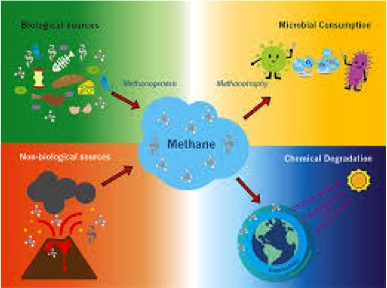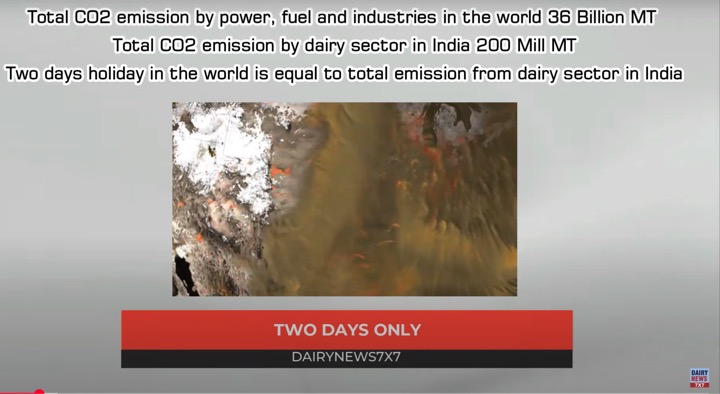A modelling study has found methane emissions from fossil fuels declined between 1990 and the 2000s and have been stable since, whereas microbes have been producing more methane of late. One reason could be an increase in cattle-rearing in Latin America and more emissions from waste in South and Southeast Asia
For the last three years, Naveen Chandra has been spending most of his days running simulations at the Research Institute for Global Change in Japan. He is trying to recreate the last 50 years of the earth’s atmosphere on a supercomputer roughly the size of an auditorium.
Mr. Chandra has been trying to answer a question that came out of his team’s research. During 2019-2020, these researchers examined the concentration of methane in the atmosphere and how it changed with time. Until the 1990s, the concentration increased, then stabilised for a bit, and then started to increase again around 2007. According to recent estimates, the atmospheric concentration of methane today is three-times what it was 300 years ago.
Where is this methane coming from? That’s what they wanted to know.
Evolving understanding
Methane is the second most abundant anthropogenic greenhouse gas after carbon dioxide (CO2) but it warms the planet more. Over a century, methane has a global warming potential 28-times greater than CO2, and even higher over shorter periods like two decades.
It wasn’t until recently that policymakers began to focus on methane vis-a-vis addressing global warming. At the U.N. climate talks in 2021, member countries launched the ‘Global Methane Pledge’ to cut the gas’s emissions and slow the planet’s warming. Yet our understanding of methane also continues to evolve.
For instance,Mr. Chandra and his team recently reported that microbes have been the biggest sources of methane in the atmosphere, not the burning of fossil fuels.
The sources of methane
Scientists are increasingly recognising various sources of methane, most of which fit in two categories: biogenic and thermogenic. When fossil fuels such as natural gas or oil are extracted from deep within the earth’s crust, thermogenic methane is released. Biogenic methane comes from microbial action.
The microbes that produce methane are archaea — single-celled microorganisms distinct from bacteria and eukaryotes — and are called methanogens. They thrive in oxygen-deficient environments, such as the digestive tracts of animals, wetlands, rice paddies, landfills, and the sediments of lakes and oceans.
Methanogens play a crucial role in the global carbon cycle by converting organic matter into methane. While methane is a potent greenhouse gas, its production by methanogens is an essential part of natural ecosystems. But human activities like agriculture, dairy farming, and fossil fuel production have further increased methane emissions.
Both biogenic and thermogenic activities produce different isotopes of methane. Tracking the isotopes is a way to track which sources are the most active.
Modelling with a supercomputer
According to Prabir Patra, principal scientist at the Japan Agency for Marine-Earth Science and Technology (JAMSTEC) and one of the lead authors of the study, carbon-13 is key. (Atoms of this carbon isotope have 13 nucleons: 6 protons + 7 neutrons.)
If there are fewer carbon-13 atoms than a certain level in a group of 1,000 methane molecules, the methane is from a biological source. If the methane is from thermogenic sources, such as trapped fossil fuels or geological activities, there will be more carbon-13 atoms in 1,000 molecules.
Mr. Chandra and Mr. Patra worked with scientists from Austria, Japan, the Netherlands, and the U.S. to collect data from the 12 monitoring sites worldwide tracking atmospheric parameters since the 1990s. Then they sorted the methane isotope data by year and ran it through a program they had developed to recreate the atmosphere from 1980 to 2020 on a supercomputer.
“One year of data analysis takes about four to five hours,” Mr. Chandra said.
Data mismatch
Finally, the team compared their own results with two emissions inventories, called EDGAR and GAINS, and found some discrepancies. EDGAR had reported that methane emissions from oil and natural gas exploration had increased between 1990 and 2020. GAINS had recorded a large “unconventional” rise in emissions since 2006. Their findings disagreed with both inventories.
Mr. Patra said combining the numbers for all biogenic and thermogenic isotopes should match the total emissions in a year. They also took insights from other available data like, number of rice fields, wetlands, dairy farms, biomass burning and likewise sources of methane emissions, and estimated the emissions from those sources. But when they ran their atmosphere models with this data, the year-wise total methane emissions overshot the total production.
In fact, the models said methane emissions from fossil fuels declined between 1990 and the 2000s and that they’ve been stable since. They also found microbes were producing more methane than fossil fuels.
Need for local data
One possible reason could be an increase in cattle-rearing in Latin America and more emissions from waste in South and Southeast Asia, Latin America, and Africa, the study’s authors wrote in their paper. They added that the number of wetlands worldwide had increased as well.
























